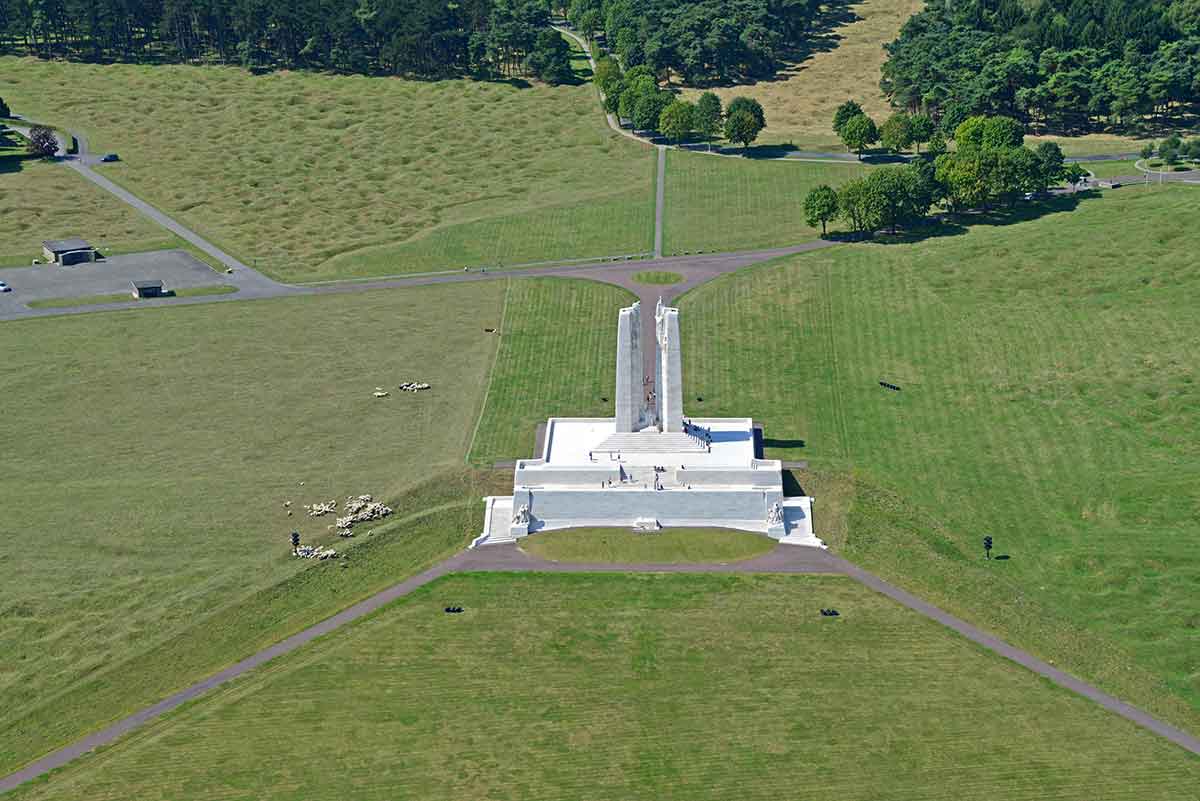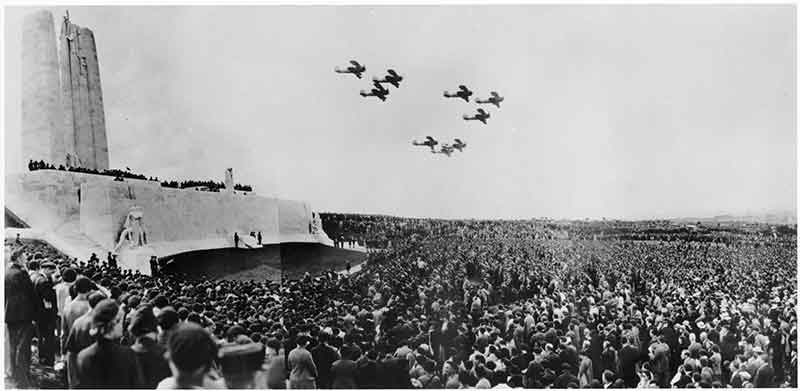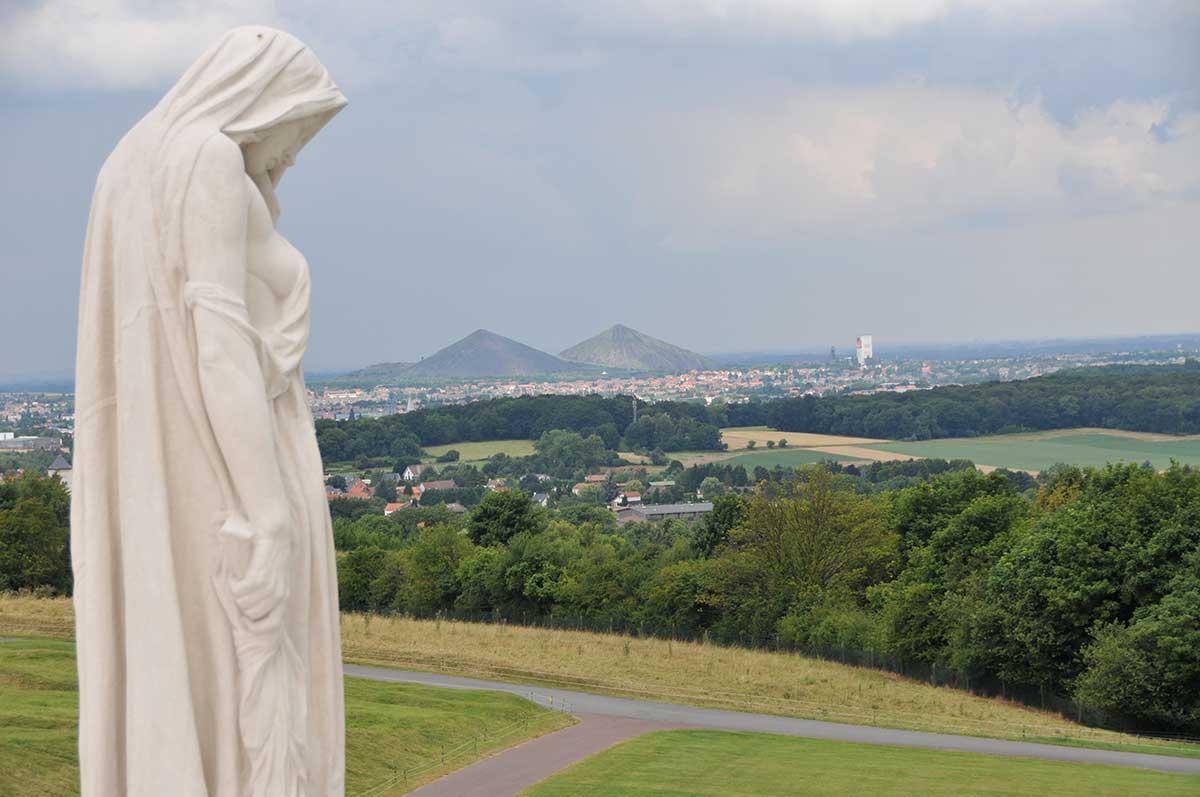The Canadian National Vimy Memorial
Introduction
This publication is available upon request in alternate formats.
PDF Version
There are many ways that Canadians have honoured those who have served our country in uniform over the years. One of the most evocative ways this spirit of remembrance has been expressed is with the majestic Canadian National Vimy Memorial which our country erected in France in the aftermath of the First World War.
The Battle of Vimy Ridge
More than 650,000 Canadians served in the First World War that raged from 1914 to 1918. Our soldiers would see much heavy action along the Western Front in France and Belgium, but the Battle of Vimy Ridge would become the most iconic Canadian action of the entire conflict.
The Canadian assault at Vimy—part of the larger Battle of Arras in northern France—began on Easter Monday, April 9, 1917. All four divisions of the Canadian Corps, made up of soldiers from coast to coast, would fight together for the first time there. Advancing behind a powerful “creeping barrage” laid down by the Allied artillery, our men captured most of the ridge by noon on the battle’s first day, with the last German resistance being overcome by April 12. The Battle of Vimy Ridge was one of the most successful Allied offensive operations to that point in the war and saw the capture of more ground, enemy artillery pieces and prisoners than any previous action by British or Canadian forces.
A Monumental Idea
The scale of the Canadian service and sacrifice during the First World War was unprecedented and the end of the conflict was accompanied by a strong public sentiment that it must never be forgotten. Thousands of monuments began to spring up in cities, towns and villages across the country. This drive to commemorate the war was also felt on a national scale as the Canadian government looked to erect memorials on the former battlefields in Europe where so many of our soldiers had fought and died.
It was decided that Canada would have eight official sites overseas to commemorate our most significant battles. Memorials at St. Julien, Hill 62 (Sanctuary Wood) and Passchendaele would be created in Belgium. Courcelette, Le Quesnel, Dury, Bourlon Wood and Vimy Ridge would be the sites for the memorials in France.
Newfoundland, which was a separate dominion at the time, also established overseas war memorials of its own at Courtrai, Gueudecourt, Masnières, Monchy-le-Preux and Beaumont-Hamel. At each site would be erected a magnificent bronze sculpture of a caribou, the emblem of the Royal Newfoundland Regiment. Responsibility for maintaining these memorials was assumed by the Government of Canada after Newfoundland later joined Confederation.
A public contest was held in the early 1920s to select the design for the Canadian monuments and it was ultimately decided that the ambitious proposal submitted by Walter Seymour Allward would be chosen for Canada’s primary First World War memorial at Vimy Ridge. A second special memorial—the so-called “Brooding Soldier” designed by Frederick Chapman Clemesha—would be erected at St. Julien, while the remainder of the overseas sites would be marked by granite blocks situated within reflective garden landscapes.
From the beginning, Allward’s vision for the monument at Vimy was to be a synthesis of art and remembrance. Its location is integral to its power as it stands on the hallowed ground where our soldiers sacrificed and achieved so much in April 1917. On some 107 hectares of land that the grateful people of France had granted to Canada after the war, the beautiful Canadian National Vimy Memorial rises from atop the highest point of the ridge, offering visitors breathtaking panoramic views. Much of the surrounding terrain was left largely untouched, making it one of the largest preserved First World War battlefields on the former Western Front. The site is crisscrossed with former trench lines, pockmarked with countless shell craters and undermined with old tunnels, making it a true glimpse into the past.
It would take eleven years to build the monument which rests on a bed of 11,000 tonnes of concrete, reinforced with hundreds of tonnes of steel. It is clad with almost 6,000 tonnes of light-coloured limestone which came from an ancient quarry on the Adriatic Sea. When the memorial was officially dedicated by King Edward VIII in July 1936, a huge crowd was in attendance which included thousands of Canadian Veterans who had made the long trip back to France.
Symbolism
Two 30-metre tall pylons soar into the sky from the Canadian National Vimy Memorial’s massive base, which Allward had designed to evoke the feel of a strong defensive bastion. The pylons, one adorned with maple leaves and the other with a fleur-de-lis, represent the nations of Canada and France that fought alongside one another during the First World War.
The monument was designed in a classical style and is adorned with 20 large allegorical figures, each with its own symbolic meaning. These sculptures were carved from massive limestone blocks, with stoneworkers using models that had been personally crafted by Walter Allward as a guide. High atop the memorial’s pylons are two figures representing “Peace” and “Justice,” while just below them are found “Faith,” “Honour,” “Truth” and “Knowledge.” Figures of “Hope” and “Charity” can also be seen near the top, as can the shields of Canada, Britain and France. On the memorial’s base between the two pylons is a young dying soldier, representing the “Spirit of Sacrifice,” alongside the “Torch Bearer.”
On the rear staircase are found the “Male Mourner” and “Female Mourner.” On the front corners of the base are “the Defenders”—three figures representing the “Breaking of the Sword” on one side and four figures representing “Sympathy of Canadians for the Helpless” on the other. Finally, the cloaked figure of a woman—carved from a single 30-tonne block of limestone—stands at the centre and overlooks the Douai Plain below. This is “Canada Bereft” and represents the mourning of a young country for its war dead. Below her lies a sculpted tomb draped in laurel branches and bearing a helmet and a sword.
Sacrifice
The Battle of Vimy Ridge was not only the site of one of our country’s most significant battlefield victories, but also one of our bloodiest. Some 3,600 Canadians lost their lives in the fighting there and more than 7,000 more were wounded. The Canadian National Vimy Memorial, however, does not commemorate only one battle. On its walls are also inscribed the names of 11,285 Canadians who lost their lives in France during the First World War and then had no known grave. Here again the artistic vision of the monument shines through as the many rows of names gracefully run in a continuous ribbon around the base of the memorial. It is humbling to gaze upon these sweeping streams of names and consider the immense scale of the sacrifices that were made. It is even more sobering to realize that these fallen were only a fraction of the overall total of more than 66,000 Canadians who gave their lives during the First World War.
Legacy
The Battle of Vimy Ridge has assumed an almost mythical meaning for many who view it as a key event in the evolution of Canada into an independent nation of its own—a ‘coming of age’ for a young country that came to pass thanks to the great courage of our soldiers there on those cold April days so long ago.
The Canadian Corps’ great victory at Vimy Ridge was part of the unbroken string of battlefield successes that marked its record in the final two years of the First World War. Our soldiers’ great successes and sacrifices on the battlefields of Europe indeed earned Canada a new respect on the world stage and a separate signature on the Treaty of Versailles that would formally end the conflict. The service and sacrifice of those who did so much in the cause of peace and freedom will never be forgotten.
Canada Remembers Program
The Canada Remembers Program of Veterans Affairs Canada encourages all Canadians to learn about the sacrifices and achievements made by those who have served—and continue to serve—during times of war and peace. As well, it invites Canadians to become involved in remembrance activities that will help preserve their legacy for future generations.
- Date modified:


